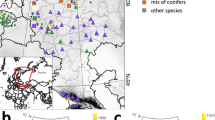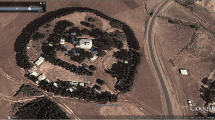Abstract
A significant amount of dendrogeomorphic research has focused recently on the effects of isolated rockfall activity on tree growth and annual rings (reviewed in Stoffel 2006, and Schneuwly and Stoffel 2008). By comparison, however, only a few studies have used tree-ring analysis in the dating of large-scale rockfall avalanches, or bergsturz (see Butler et al. 1986). Butler et al. (1986, 1991, 1998) examined a number of rockfall avalanches in Glacier National Park, Montana, USA, and used tree-ring analysis of trees severely tilted and/or scarred along the margins of the rockfall-avalanche deposits to date three of those deposits – Slide Lake at 1910 (Fig. 1), Slide Pond at 1946 (Fig. 2), and Napi Point at 1954.
Access provided by Autonomous University of Puebla. Download chapter PDF
Similar content being viewed by others
A significant amount of dendrogeomorphic research has focused recently on the effects of isolated rockfall activity on tree growth and annual rings (reviewed in Stoffel 2006, and Schneuwly and Stoffel 2008). By comparison, however, only a few studies have used tree-ring analysis in the dating of large-scale rockfall avalanches, or bergsturz (see Butler et al. 1986). Butler et al. (1986, 1991, 1998) examined a number of rockfall avalanches in Glacier National Park, Montana, USA, and used tree-ring analysis of trees severely tilted and/or scarred along the margins of the rockfall-avalanche deposits to date three of those deposits – Slide Lake at 1910 (Fig. 1), Slide Pond at 1946 (Fig. 2), and Napi Point at 1954.
Photo from helicopter taken by author in 1995, showing Slide Lake in lower right portion of photo and its damming rockfall-avalanche deposit and Slide Pond and its damming rockfall-avalanche deposit (center left). Note difference in revegetation on the surfaces of the 1910 Slide Lake versus the 1946 Slide Pond deposits
Recently, several dendrogeomorphic works examining snow-avalanche occurrence have advocated “weighting” tree-ring data, in some cases by concentrating only on unequivocal corrosion scar and strong reaction wood evidence (Germain et al. 2005; Butler and Sawyer 2008; Reardon et al. 2008). I suggest here that similar weighting is useful in dating the year of occurrence of rockfall avalanches.
Tree rings (Butler et al. 1986, 1991) illustrated the age of the Slide Lake rockfall avalanche as occurring in 1910; subsequent to that confirmation, previously unknown historical documents were located that confirmed the year of occurrence as 1910 (summarized in Butler et al. 1998). The tree ring evidence for 1910 was, however, only marginally stronger than was evidence for years a few years earlier (1908 and 1909) or later (1911 and 1912) (Oelfke 1984), when using all tree-ring growth responses present from trees tilted and scarred by the rockfall avalanche (corrasion scars, reaction wood onset and continuation, suppression, and release rings): 1908 had an index value (see Butler and Sawyer 2008) of 10, indicative of 10% of sampled trees illustrating response for that year (cross-cut samples from 21 trees of an original sample of 30 trees were sufficiently old to extend back to the early twentieth century); 1909, index value (IV) of 24; 1910, also an IV of 24; 1911 an IV of 10; and 1912 an IV of 14 (Table 1). Using a weighted system similar to that described for snow avalanches by Reardon et al. (2008), in which only corrasion scars and associated onset of reaction wood, or strong onset of reaction wood without scarring that lasted for a minimum of three years, were used to calculate annual index values, the Slide Lake data illustrated a much clearer picture supportive of the date of 1910 (Table 1): 1908 IV of 5, 1909 IV of 10, 1910 IV of 19, 1911 IV of 10, and 1912 IV of 0. Essentially, using the strongest data (scars and strong, long-lived onset of reaction wood) produced an Index Value almost twice as strong for 1910 as for any other year. Applying the same system (without using weighting versus using weighting), the following results emerged for the 1946 Slide Pond and the 1954 Napi Point rockfall avalanches: Slide Pond, 1944 9 versus 4, 1945 4 versus 4, 1946 70 versus 65, 1947 57 versus 22, and 1948 13 versus 4; Napi Point, 1952 9 versus 0, 1953 9 versus 0, 1954 83 versus 83 (these were excellent samples!), 1955 17 versus 17, and 1956 17 versus 13. Using only the clearest, most distinct displays of scarring and strong and continuous reaction wood clearly pinpointed the year in all three cases in which the large and potentially very hazardous rockfall avalanches occurred, and is recommended for dating of other rockfall avalanche deposits of unknown age.
References
Butler DR, Sawyer CF (2008) Dendrogeomorphology and high-magnitude snow avalanches: a review and case study. Nat Haz Earth Syst Sci 8:303–309
Butler DR, Oelfke JG, Oelfke LA (1986) Historic rockfall avalanches, northeastern Glacier National Park, Montana, USA. Mt Res Dev 6:261–271
Butler DR, Malanson GP, Oelfke JG (1991) Potential catastrophic flooding from landslide-dammed lakes, Glacier National Park, Montana, USA. Z Geomorphol Suppl 83:195–209
Butler DR, Malanson GP, Wilkerson FD, Schmid GL (1998) Late Holocene sturzstroms in Glacier National Park, Montana, USA. In: Kalvoda J, Rosenfeld C (eds) Geomorphological hazards in high mountain areas. Kluwer, Dordrecht
Germain D, Filion L, Hétu B (2005) Snow avalanche activity after fire and logging disturbances, northern Gaspé, Quebec, Canada. Can J Earth Sci 42:2103–2116
Oelfke JG (1984) The location and analysis of landslides along the Lewis Overthrust Fault, Glacier National Park, Montana. Thesis, Oklahoma State University, Oklahoma
Reardon BA, Pederson GT, Caruso CJ, Fagre DB (2008) Spatial reconstructions and comparisons of historic snow avalanche frequency and extent using tree rings in Glacier National Park, Montana, USA. Arct Antarc Alp Res 40:148–160
Schneuwly DM, Stoffel M (2008) Tree-ring based reconstruction of the seasonal timing, major events and origin of rockfall on a case-study slope in the Swiss Alps. Nat Haz Earth Syst Sci 8:203–211
Stoffel M (2006) A review of studies dealing with tree rings and rockfall activity: the role of dendrogeomorphology in natural hazard research. Nat Haz 39:51–70
Author information
Authors and Affiliations
Corresponding author
Editor information
Editors and Affiliations
Rights and permissions
Copyright information
© 2010 Springer Science+Business Media B.V.
About this chapter
Cite this chapter
Butler, D.R. (2010). Tree-Ring Analysis and Rockfall Avalanches: The Use of Weighted Samples. In: Stoffel, M., Bollschweiler, M., Butler, D., Luckman, B. (eds) Tree Rings and Natural Hazards. Advances in Global Change Research, vol 41. Springer, Dordrecht. https://doi.org/10.1007/978-90-481-8736-2_9
Download citation
DOI: https://doi.org/10.1007/978-90-481-8736-2_9
Published:
Publisher Name: Springer, Dordrecht
Print ISBN: 978-90-481-8735-5
Online ISBN: 978-90-481-8736-2
eBook Packages: Earth and Environmental ScienceEarth and Environmental Science (R0)






